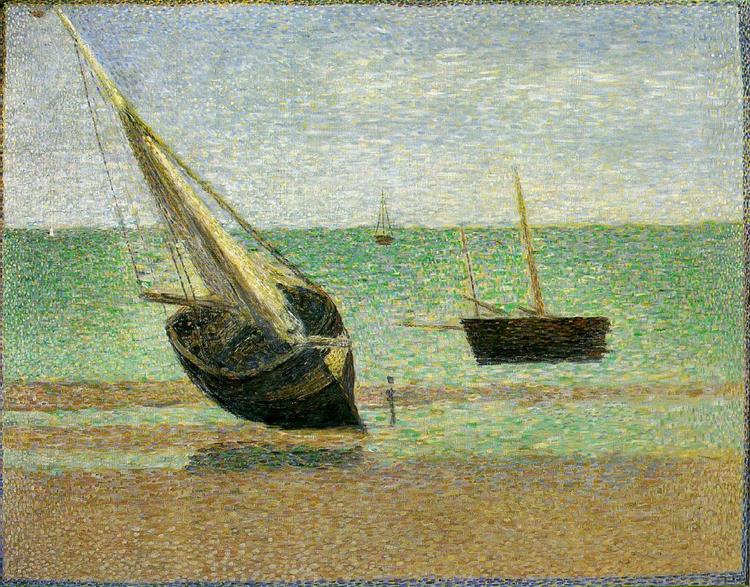Description
Georges Seurat's "Low Tide at Grandcamp" (1885) is a brilliant example of the pointillist movement and the artist's ability to capture light and mood through colour. This painting depicts a seaside scene that, like many of Seurat's works, is characterised by a unique atmosphere and an almost poetic sense of time and place.
Known for his innovative technique, Seurat uses pointillism to create a vibrant painterly surface composed of small colored targets that, when viewed from a distance, merge in the viewer's eye. The color palette in "Low Tide at Grandcamp" is dominated by blue and green hues that evoke the freshness of the ocean, contrasted by the earthy, golden tones of the beach and sky. This choice of colors not only offers a naturalistic depiction of the coastal landscape, but also creates a dynamic play of light and shadow that is one of the hallmarks of Seurat's style.
The composition of the work is carefully balanced, with the arrangement of elements drawing the viewer's gaze towards the sea horizon. Although human figures are present, they are in a calm state, as if they were part of the landscape rather than actors disturbing the scene. Seurat succeeds in depicting human existence in a natural context, suggesting an intimate connection between humanity and the environment we inhabit. The figures, although only shadows at certain times, possess a tangential quality, suggesting a reflection on the ephemeral experience of life and the immutability of nature.
A fascinating aspect of the painting is the attention Seurat pays to detail. Boats gliding smoothly through the water and objects on the beach, such as shells and rocks, are minutely depicted, adding a sense of reality to the work and emphasizing the complexity of the marine ecosystem. This fascination with detailed observation reflects the influence of naturalism that was prevalent in art before the arrival of Impressionism.
In addition, “Low Tide at Grandcamp” offers a glimpse into the beginnings of Seurat’s style, which is based on his early explorations of color and light. This particular work, which emerged from his visit to the Normandy coast, is a testament to his transition to the more defined use of color that would characterize his later works, such as “A Sunday Afternoon on the Island of La Grande Jatte.”
Seascapes were a recurring theme in Seurat's work, forming part of his broader exploration of the human figure and its interaction with the environment. The simplicity and calm of this scene in "Low Tide at Grandcamp" contrasts with the emotional and social complexity found in his most famous work, thus offering a contemplative respite. Through his distinctive technique, Seurat opens a dialogue between the viewer and the landscape, inviting us to reflect on our relationship with nature and the passing of time.
Ultimately, "Low Tide at Grandcamp" is not just a depiction of a coastal landscape, but a meditation on light, time, and the coexistence of human beings with their environment. The work is a compendium of Seurat's technical mastery, his profound understanding of light, and his ability to capture the spirit of a specific moment in nature, thus anchoring its place in art history.
KUADROS ©, a famous painting on your wall.
Hand-made oil painting reproductions, with the quality of professional artists and the distinctive seal of KUADROS ©.
Painting reproduction service with satisfaction guarantee. If you are not completely satisfied with the replica of your painting, we will refund 100% of your money.

